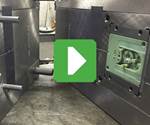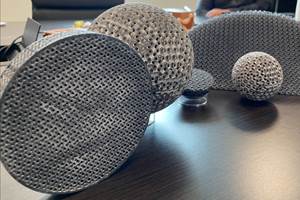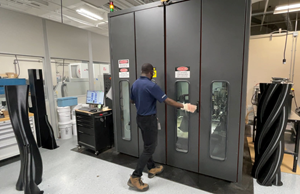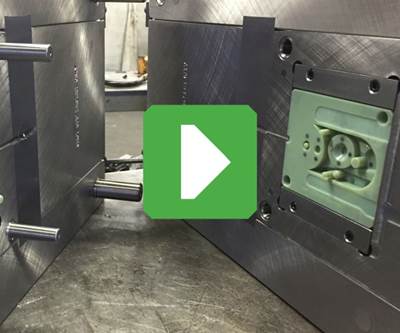Direct Versus Indirect Tooling and Beyond
As new materials are introduced to the RP industry, it may be worthwhile to revisit processes that have been previously dismissed as not being viable.
Over the past decade, as additive fabrication technology has matured, so have the applications for use in rapid tooling. Two broad categories of rapid tooling exist: Indirect or Pattern-based Tooling approaches use master patterns to produce a mold or die, and Direct Tooling, where the additive process builds the actual molds.
Though interest in using additive processes to solve tooling problems continues, few have reached the point where they are commercially viable. This is especially true in plastic injection mold tooling, where CNC and high-speed machining tends to be the defacto-standard. In other areas such as urethane and silicone casting along with pattern-based metal casting, rapid prototyping has become the standard. This is especially true when complex geometry is required such as hidden or "trapped" features as seen in investment cast parts.
High-performance tooling is another topic that has generated interest in recent years because molding cycle time can be more important than the time it takes to produce the tool. Some indirect and direct rapid prototyping technologies are being applied to achieve improved thermal properties that cannot be realized with conventional machined tools.
One such beneficial method is to create conformal-cooling channels within the tool that remove heat from the mold faster than straight-line channels in machined tools. These channels allow coolant to pass through the mold in a pattern that conforms to the shape of the mold cavity. Fast4M (Detroit, MI), a metal laminate tooling company, has generated direct tools for injection molding with complex, rough-surface interior cooling line channels, which generated additional cooling due to turbulent fluid dynamics. This can reduce injection-molding cycle times, which increases production rates, lower part costs and can even improve part quality.
Another method of thermal management is the use of functionally graded materials. The idea is to use a hard, resistant material, such as H13 tool steel, for the surface of the mold and a highly conductive material, such as a copper alloy, for most of the remainder of the mold. RSP Tooling, LLC (Solon, OH), a pattern-based spray metal tooling method, has used this approach for injection molds tools. LENS technology from Sandia Labs has been applied to directly produce molds and dies with copper cores.
Pattern-Based or Indirect Tooling
Most any rapid prototyping process can yield patterns for indirect tooling. The accuracy of these production processes depends, in large part, on the accuracy of the additive process used to create the pattern. Therefore, processes such as SLA that have relatively good accuracy and feature resolution, have been used predominantly. In some cases, such as plaster casting or RPM (Rubber Plaster Mold), where sacrificial plaster molds for metal casting are pulled from a silicone rubber mold, a pattern reversal is applied to cast the production pattern in a more durable material than the original RP component.
RSP Tooling
The Rapid Solidification Process (RSP) starts with a pattern of the tool being generated from a CAD solid model. A ceramic reversal is poured and created from this pattern. From a crucible, molten metal is fed to a nozzle and atomized by contact with a high velocity gas jet. A five-axis manual gripper holds the ceramic pattern as a spray system and deposits the metal from a fixed nozzle. Tool steel or another metal is sprayed onto the ceramic to form the pattern's shape, surface texture, detail and required thickness.
It is possible to spray many tooling alloys, including tool steels such as P20, H13 and D2, and is known for the ability to replicate very fine details. RSP Tooling has also begun to produce bimetallic tools for die casting and plastic injection-molding applications for improved thermal conductivity. The primary limitations of the process are maximum part size and features with aspect ratios greater than 2:1. The beta RSP Tooling machine is capable of spraying inserts that weigh up to 27 kg (60 lbs) and measure 178 x 178 x 100 mm (7 x 7 x 4 inches). RSP Tooling is now selling tool inserts primarily in the forging and die casting markets.
Reconfigurable Tooling
Reconfigurable Tooling Systems (also known as Reformable Tooling Systems) are based on proprietary state-change materials that have been developed by 2Phase Technologies (Dayton, NV). The state change material consists of a mixture of particles and liquid. This solid and liquid combination creates a fluid-like mixture that can be transitioned to a solid state when the liquid is removed by surrounding the material in thin latex and pulling a vacuum. Following the transition to the solid state, the material forms a stable ceramic with the addition of heat. This tool can then be directly used for composite lay-up or with removing the latex cover, the porous material allows for efficient use as a vacuum-forming pattern. Some organizations are also experimenting with urethane and foam molding along with other production processes (see Figure 1, page 18).
The most unique aspect of this process is the ability to reverse the process by adding water back to the matrix, which returns it to the original soft state, thus allowing the operator to quickly create the next required tool. 2Phase has also developed a water bed-like unit that is placed on parts or patterns in situ. These portable tooling blankets are being used by the U.S. Air Force to produce splashes and tools of wing shapes for aircraft in the field without needing any disassembly. The largest 2Phase tooling system can fabricate tools up to 153 x 122 x 46 cm (5 x 4 x 1.5 feet) and they are currently working on a much larger build envelope.
RTV/Silicone Rubber Tooling
RTV molding, also known as silicone rubber tooling, continues to be very popular and is used extensively for the casting of urethane parts. With this process, mold costs tend to be relatively inexpensive and they frequently take less than two to three days to produce on average. Most any object can be used as a pattern, including not only rapid prototypes, but also machined components, sulfur-free clay and existing natural and man-made components. The resulting cast urethane, epoxy or silicone rubber components made from the tooling can closely simulate the final production material properties, finish, color, etc.
Though some urethanes set in under one minute, the process tends to be slower, especially with soft Durometer materials. Additionally, mold life can typically only produce between 25 to 50 parts depending on geometry and materials. Though there are many cases when casting up to several hundred parts makes sense with RTV molding, with cost and speed improvements in rapid injection molding, many folks choose this tooling process for 20 to 100 components.
The challenge continues to be to cast thermoset materials that can very accurately simulate the final production material in terms of stiffness (modulus), elongation, tensile strength and toughness of the material combined together. There are a few licensed technologies that are being developed that allow for the casting of true thermoplastic materials to be cast in RTV molds by using the plastic prepolymer and additional catalysts.
Other Pattern-Based Tooling Options
Though many of the above processes have either been successfully commercialized or are in the process, there are many other forms of pattern-based rapid tooling technology that have had market penetration. Some of these include epoxy-based composites, cast kirksite, 3D keltool, MetalCopy PHAST, Rapid Molding Technologies, laminate tooling, space puzzle molding, Vprocess (vacuum casting), plaster casting or RPM (Rubber Plaster Mold) and spray metal tooling (Ford Sprayfrom and others similar to RSP mentioned above). Many of them are explained in Wohlers Report 2006. Visit >http://wohlersassociates.com/tooling2006.pdf for details.
For investment casting of metals, many organizations continue to apply Quickcast (3DSystems), a form of SLA that forms a sparse interior structure as to burn-out easier in the furnace. Additionally, the Thermojet (3DSystems) produces wax patterns directly as does the ModelMaker II (Sanders/Solidscape). The ModelMaker II is the highest resolution additive process building in less than 0.0005" layers, however the build speed is slow, so it is mainly used for highly detailed components like jewelry patterns. Other plastics and photopolymers are also being used as patterns for investment casting.
Direct Tooling
Direct approaches to rapid tooling do not require the production of a pattern. Instead, additive processes are used to produce tooling inserts directly. These approaches can potentially reduce the number of steps in the process and potentially impact overall part accuracy. The limitation in additive fabrication of tooling tends to be the required post-processing to achieve the required surface finish. Some processes like DMLS (EOS) and Laser Consolidation (Accufusion) have good raw finishing results, but typically mold inserts require additional polishing. Beyond metal rapid tooling, plastic (or resin) rapid prototype molds are also frequently produced for a variety of purposes like casting urethanes and silicones.
Laser Consolidation
Accufusion Inc. (London, Canada) has developed a process called Laser Consolidation (LC), a material deposition technique for producing metal parts and tooling. LC is similar to Laser Engineered Net Shaping (LENS), a technique developed at Sandia Labs and commercialized by Optomec that combines powder deposition and a laser to produce metal parts. Tolerances of ± 0.05 mm (0.002 inch) have been achieved with a high-quality surface finish of 1 to 7 mm Ra with no post-processing (see Figure 2, page 18).
The standard build volume is 500 x 500 x 500 mm (20 x 20 x 20 inches) and is capable of producing very fine and complex details and thin-walled parts that are 0.75 to 1.5 mm (0.030 to 0.060 inch) in thickness. Materials currently available include 316 and 420 stainless steels, Inconel 625, Inconel 738, Ti-6Al-4V titanium alloy, Aluminum 4047, Stellite 6, wear-resistant CPM-9V tool steel and H13 steel. In exchange for having one of the best surface finishes in additive fabrication, the speed of the process is slow.
SLS Tooling
Selective Laser Sintering (SLS) from 3D Systems creates metal parts and tooling inserts using powder metal and laser-sintering techniques. This material consists of particles of 420 series stainless steel or A6 tool steel that are coated with a thin layer of a polymer binder material. The SLS machine produces "green" parts that are then fired in a furnace or oven. The furnace cycle burns out the binder material, sinters the steel particles into a porous metal matrix and infiltrates bronze into the parts through capillary action.
The process produces a fully dense part that consists of about 55 percent steel and 45 percent bronze. Similar to most other direct tooling of metals, mold size typically needs to be small to be proven cost-effective.
DMLS Tooling
Direct Metal Laser Sintering (DMLS), a technology commercialized by EOS (Deggendorf, Germany), fuses metal powder into a solid part by melting it locally using a focused laser beam. Parts are built up layer by layer, allowing for highly complex shapes to be created directly from CAD data with good accuracy, resolution and mechanical properties of the finished parts. DMLS has the ability to produce very fine features and thin walls, and the resulting surface finish is quite good (see Figure 3, page 22).
New materials available in DMLS include CoCrMo and 17-4 alloys. Ti6AlV4 titanium alloy and MaragingSteel MS1 are also being introduced this year. This process is being considered for producing complex, fully functional metal parts and inserts. EOS markets the EOSINT M 270 metal system and sells the EOSINT M 250 Xtended system, but the more recent alloys must be run on the M 270, which has a different build chamber and uses a Yb-fiber 200Wlaser.
3D Printers for Direct, Rapid Tooling
Since 3D printers have matured greatly in terms of ease-of-use, cost and quality, it is important to not overlook their usefulness for direct, rapid tools. FDM, MJM (Invision and Thermojet from 3DSystems), Polyjet (Eden from Objet) and many others have the ability to directly produce molds for urethane or silicone rubber casting. Z-Corp has also licensed the Z-Cast process, which allows users to directly produce plaster shells for metal casting. A unique feature to consider with the use of RP for rapid tooling is that typically up-facing surfaces do not have a support structure as do down-facing surfaces. When producing a two-part tool, A-side finish requirements will naturally be made facing up (and thus with a better finish and less post-processing).
Others
Other technologies for tooling include Solidica, Inc. (Ann Arbor, MI), a company with an additive method for aluminum parts and rapid tooling using ultrasonic welding technology. Another is the ProMetal Division of Ex One (previously known as Extrude Hone) (Irwin, PA). It has a process that uses metal powder and MIT's 3DP technology to produce parts and mold components. LENS has been commercialized by Optomec who offers a system designed to produce metal parts and mold inserts. POM offers a similar process called Direct Metal Deposition. Arcam (Mölndal, Sweden) offers a metal process named Electron Beam Melting. Concept Laser (Lichtenfels, Germany), F&S/MCP (Germany), Phenix Systems (Clermont Ferrand, France) and Trumpf (Ditzingen, Germany) offer systems that use methods of laser melting.
CNC vs. Additive
Machining is an established technology that is well understood by thousands of companies. It is not subject to the material, size, and accuracy limitations that are inherent with most unconventional processes of making tools. Also, companies have reduced the time to produce molds to less than one week for relatively small, single-cavity molds. Fast mold production time is the result of improving the management of the process as much as from improving the technology itself. Many years ago, companies were not under as much pressure to develop new products quickly.
CNC production of tooling has benefited tremendously from advancements in progressive automated software algorithms and high speed CNC milling. Protomold (Maple Plain, MN) can produce CNC-cut tooling and simple injection-molded parts with up to four side actions in three days from the time it receives the customer's CAD data. In early 2007, Protomold announced nextday injection molding services. A challenge that remains for CNCproduced tooling is that the features of the design drive costs and schedules. This is much less of an issue when considering the use of an additive process, but it limits CNC's cost-effectiveness for small, complex objects and adds time to the production cycle due to design iterations for manufacturability.
Summary
As new materials are introduced to the RP industry, it may be worthwhile to revisit processes that have been previously dismissed as not being viable. For example, Direct AIM is one of the early SL rapid tooling processes for injection molding. It is now being implemented more effectively using ceramic-filled Prototool SL material from DSM Somos (New Castle, DE). Post processing techniques, such as nickel-plating, is also opening the door for new rapid tooling processes.
The "best" tooling process depends on the application. You must consider accuracy and material requirements, the quantity of parts required, part size, geometric complexity, cost and leadtime. Some of the tooling methods discussed in the previous section are being improved continuously, and new tooling methods are being developed.
It is important to consider that company changes take a long time to implement. Even as very effective rapid tooling methods evolve, most companies will continue operating with their current processes due to the fact that they are knowledgeable, efficient and most-importantly, comfortable with their current methods. As the cost of implementation lowers in combination with the quality and speed, the overall return on investment will drive companies into change. Additionally, the most effective driver for change can be competition. Companies will often implement process changes to keep up with pioneering competitors. TCT
Related Content
Better, More Compact Radio Frequency Devices Through 3D Printing
3D printing technology company Fortify is applying its photopolymer process and material developed with Rogers Corporation to serve the expanding RF market.
Read More8 Social Media Posts About Additive Manufacturing: AM Radio #34
Cost savings, modifications, large-format AM and more. In this episode of AM Radio, we discuss what people are saying about additive manufacturing on social media.
Read MoreEaton Developing Carbon-Reinforced PEKK to Replace Aluminum in Aircraft Air Ducts
3D printable material will meet ESD, flammability and other requirements to allow for flexible manufacturing of ducts, without tooling needed today.
Read MoreRobot Vs. Gantry for Large-Format Additive Manufacturing (Includes Video)
Additive Engineering Solutions, specialist at 3D printing very large parts and tools on gantry machines, now also uses a robot for large-format AM. Here is how the robot compares.
Read MoreRead Next
Video: Additive Manufacturing Offers a Tooling Alternative
3D printing can offer a cost-effective alternative to conventionally produced tooling for those processes that depend on it.
Read MoreCrushable Lattices: The Lightweight Structures That Will Protect an Interplanetary Payload
NASA uses laser powder bed fusion plus chemical etching to create the lattice forms engineered to keep Mars rocks safe during a crash landing on Earth.
Read MorePostprocessing Steps and Costs for Metal 3D Printing
When your metal part is done 3D printing, you just pull it out of the machine and start using it, right? Not exactly.
Read More




















